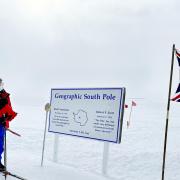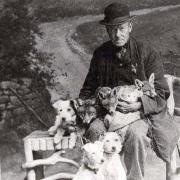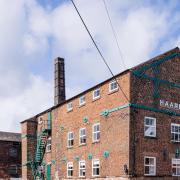Derbyshire Life meets Derbyshire-born Rachel Cutting MBE, principal embryologist at the Jessop Wing of the Hallamshire Hospital

‘DEEP breath, shoulders back, smile and just get on with it,’ – this is the creed of Derbyshire born-and-bred career woman and mother of two, Rachel Cutting. And this practical motto of knuckling down, being resilient and determined has borne fruit for the 42-year-old who is principal embryologist at one of the most successful fully NHS managed Assisted Conception units in the UK.
Just last year Rachel was awarded an MBE in the Queen’s Birthday Honours List, for services to infertility and was dubbed Healthcare Scientist of the Year in 2012. She has been instrumental in helping bring about many of the 3,000 IVF babies born since the unit, based at the Jessop Wing of the Hallamshire Hospital and part of the Sheffield Teaching Hospitals NHS Trust, opened in 2001 – bringing joy to countless parents from across Yorkshire and Derbyshire.
The girl who grew up in the quiet rural farming community of Barlow, North Derbyshire, has also made a significant contribution to research and development of the embryology profession in the UK and has driven changes in the way IVF treatment is carried out across the country. She is also committed to sharing best practice across the globe, running teaching workshops in countries as far afield as Iran, China and Myanmar.
Yet despite this enviable track record, Rachel simply sees herself as a member of a tight knit and successful team at her workplace. It’s just her ‘second family’ and her ‘second home’. And she is extremely keen to dismiss any sober academic image.

We met up at her workplace, where she has spent much of the past 21 years, and despite donning a white head-to-toe lab suit before showing me the scientific magic of the world-class IVF labs, I notice her colourful pink lipstick, a welcoming smile and a reassuringly down-to-earth manner.
‘Scientists are often seen as mad professors wearing white coats, but I prefer to put patients minds at rest and to show that we are considerate, compassionate and caring people. We have great empathy for our patients and respect their dignity.’
Quality relationships with patients are of key importance to Rachel, who explains that the small unit offers one and a half hour initial nurse-led consultations with patients, a far cry from the hurried and pressurised average GP encounter.
‘Patients are giving us their eggs and sperm so they have to put their trust in us to look after their embryos which are their future children, so for me building a good relationship with a patient is very important.’

Although IVF babies were once commonly referred to as test tube babies, the fertilisation of egg and sperm is actually undertaken in a plastic Petri dish. The embryo is grown for up to five days outside the womb and then transferred back to the woman.
At Sheffield – where there are a significant number of Derbyshire patients – the current chances of a successful pregnancy outcome are 47 per cent – a ten per cent increase since last year alone.
Rachel’s enthusiasm for witnessing the act of creation, outside the body, in a Petri dish, has never waned since she began training and although she is responsible for managing the lab, writing national training schemes for embryologists, developing the curriculum and lecturing, she still manages to undertake a lot of routine embryology.
‘I get such a buzz looking through a microscope and you see the egg and the sperm buzzing around it and I get so excited that it could become a baby.

I love the science and the biology fascinates me – to see a cell dividing and an embryo develop!’
Many patients, for whom IVF is successful, repeatedly return to the unit with their babies, bringing photographs at birthdays and Christmases – and the visitor can’t help but notice the pin board in reception crammed with snapshots of beautiful babies supplied by proud and grateful parents.
She said: ‘I feel hugely involved in the care of patients because I speak to them on a daily basis when the embryos are in the lab and there isn’t a day goes by when I don’t check the daily pregnancy test list. Of course it always makes you smile when you have been successful.’
Rachel added: ‘It’s not just about someone coming in, having a baby and going away, a lot of patients come back have second and sometimes third babies and we get to know them. We are effectively creating families and that is lovely.’
A central plank of Rachel’s work, which partly led to her being awarded Healthcare Scientist of the Year, by the Chief Scientific Officer of the Department of Health in 2012 and the MBE in 2015, has been her pivotal role in the ‘One At A Time’ project, set up by the HFEA (Human Fertilisation and Embryology Association).
The project members, multi-disciplinary team of doctors, counsellors, paediatricians, obstetricians and patient groups, recognised that the biggest single risk to the health of both mothers and babies following IVF was twin (or multiple) pregnancies and aimed to reduce this hazard scientifically by advocating Single Embryo Transfer.
Rachel said: ‘People think of twins and triplets when they think of IVF but we wanted to provide a more ethical treatment one in which we considered what is best for families and for babies and that involves producing children one at a time.’
She added: ‘Although you see lots of healthy twins on the front of magazines, a lot of twins are actually born very prematurely and very poorly and the best thing we want for our patients is for a pregnancy to be successful.’
The former pupil of Barlow Church of England School worked collaboratively to drive forward a national programme advancing Single Embryo Transfer, writing guidelines which changed clinical embryology practise in the profession as a whole and made Single Embryo Transfer (SET) a routine way of working.
At the time of the inception of the One At A Time project, in 2008, one in four IVF pregnancies were multiple birth, compared to one in 80 in the general population, but now the figure is down substantially to one in ten – in line with HFEA guidelines.
At the Assisted Conception Unit in Sheffield, it is already below that figure.
But changing the culture of practice wasn’t initially an easy step.
She explained: ‘It was very difficult to push the agenda on this as patients want to be successful and NHS funding is limited so if they are only allowed one NHS cycle of IVF treatment they may want two embryos transferred back because they think this will increase their chances of having a baby.’
But pregnancy rates have not gone down with SET and one reason for this is the ability to select the best and healthiest embryo for the patient using new technologies. A leap forward has been achieved at the Assisted Conception unit at Jessop Fertility with a state-of-the-art time lapse imaging facility, which reveals the amazing structural cell changes an embryo undergoes within the first five days of life.
‘In the lab we look at embryos from 0-5 days old and each embryo develops differently and it is our job to select the best embryo with a chance of becoming a baby. Until recently people could only get a snapshot of an embryo by taking it from its incubator once a day to look at it using a microscope. The new technology is a camera within an incubator which can take a picture of the embryo every ten minutes and you can watch the embryo develop constantly. It’s amazing that this has driven our success rate up. It allows us to select stronger embryos so there is more chance of getting a baby.’
She said: ‘If you have a good chance for IVF working: you are young, it’s your first cycle of treatment and you have got quality embryos, you only need one to work.’
She added: “We are very careful how we select and how we decide who has one or two embryos back and in this way you do not compromise anybody’s chance.’
In 2015 60 per cent of the 700 IVF procedures carried out at Rachel’s unit required only one embryo transfer.
Rachel who lives in Walton, Chesterfield, with her partner of eight years Chris Mapp, knew from a young age that she wanted to work in science. She studied physiology and biochemistry at Nottingham University from 1991 to 1994. ‘We did a lot of reproduction modules and it completely captured my interest.’
When she visited the former Infertility Research Unit at the former Jessop Hospital in Sheffield she was smitten. ‘It amazed me what you could do for people and that was when I decided I would go into IVF. Twenty-one years later, I still love it!’
Rachel’s career prompted her to have children relatively young in life. Eldest son Joe was born when she was 25 years old and Henry when she was 29.
‘Being aware of infertility prompted me to get on with having children. Working in IVF makes you realise that having children doesn’t always happen automatically and the biology side of things made me realise you should not leave it too late.
‘This is an important message for women now because we have careers, mortgages to pay and a lot of demands are put on us in our working life.
‘If people think they have a problem they should go to their GP and get referred because once you get to the age of 40 you have a less than 10 per cent chance of becoming pregnant.’
At the Assisted Conception Unit, the average age of a patient is 34 years old but some come in their early 20s and others in their mid 40s. With more babies now being born to women in their 40s than to teenagers Rachel is keen to warn that fertility declines with age and that one in six couples now need IVF to conceive.
She said: ‘We now do a lot of education work with local schools and this involves making pupils think about when it is best to have a family.’
During Health Care Science Week visits to schools – for example Rachel visited Hope Valley College in 2014 – she has been delighted to witness an increase in the interest of girls in careers in science. Embryology has always been a female dominated profession and Rachel has never felt hampered in her career by being female.
‘I’ve always worked full-time and had tremendous support from parents on both sides. They have taken the children to GP appointments, scouts and swimming lessons. The children may have missed out on some things such as me not being able to attend plays at school, but you just have to juggle the best you can. My strap line should be deep breath, shoulders back, smile and just get on with it. There’s always so much to do. Washing to put on, children’s sandwiches to make and work tomorrow.’
Rachel’s parents Julie and Michael Ferreday still live in Barlow in the house of Rachel’s childhood. Her family is rooted in Derbyshire, her paternal grandfather was a miner at Bolsover pit and her mum’s dad was an electrician at Pleasley colliery – and living relatively close to her parents has helped Rachel achieve a career she had never planned.
‘There’s no way I could have worked full time and had the career I have had without their help,’ she said.
When Rachel heard in May 2015 that she was to be awarded an MBE in she was in a state of shock. ‘I’d had a very busy Saturday at work and when I got home my eldest son Joe was revising for GCSE exams.
‘I saw the letter from the Cabinet Office and thought “Oh my goodness what have I done wrong?”
‘I remember opening it, almost shaking and being in shock. I passed it to Joe and said “Is this what I think it is?” and he joked, “Oh you’ve got the award for being the most boring embryologist!”’
She found it very difficult not to reveal the news to her parents until the allotted 13th June. She chose to make the announcement at The Tickled Trout in Barlow, which is owned by her partner Chris, son of Karen and Derek Mapp, a former High Sheriff of Derbyshire.
‘It was very emotional because they have supported me and I could never have got where I am without that support.’
The entire family joined her in London, with Chris and the boys attending the palace for the presentation by Prince William. ‘I was just amazed that he knew who I was and asked how long I had worked in IVF. He joked that he was glad he had children one at a time and I told him being a parent didn’t get any easier as the children get older. He was so relaxed and personable and put me at my ease. I always try to work hard and do my best so it was really nice to get recognition for that.’
During Rachel’s career, she has written national training schemes for embryologists, co-ordinated curriculums, been the Chair of the Association of Clinical Embryologists, taught overseas for the International Federation of Fertility Societies, and written papers for academic texts.
Earlier in the year she lectured in Myanmar, Cyprus and the Ukraine and is planning to lecture in Hong Kong in November and Costa Rica in December.
‘I’m fortunate to have had a lot of career opportunities and I never say “No!”’ said Rachel.
But there is always an exception to a rule. In 2007 Rachel was offered a very tempting permanent post in Australia, whilst out there lecturing. It was a well paid consultancy post and she was required to give her answer on returning back to the UK. Often on her way from work to her family home in Chesterfield Rachel routinely stops the car to take photos – a sunrise, a snow scene, a low mist, the change of colour of the heather on the moors, the deer at Owler bar and the barn owl she frequently waits for near Eastmoor on the road between Carver and Chesterfield. On the return from Manchester airport following the long flight from Australia it was no different.
‘I landed at 6am in Manchester and was driving back home to Chesterfield on the A6 through the Peak Forest. I got to a bend in the road with a lay-by and stopped. It was frosty over the green fields; there were dry stone walls and a low mist. It was my England moment. I looked over the beautiful Derbyshire countryside and knew then I couldn’t ever leave. And I still fundamentally love my job here, working in our wonderful NHS. I’m passionate about the NHS.’



























